So, two weeks later, with a week away boating in Door County, I managed to get the project completed.
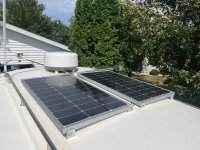
This is the completed panel installation. Nice fit on both sides of my mast light, allowing me to still fold it down (aft). And I still have some room on the back of the roof to store my un-inflated kayaks, or while no desire now, possibly another solar panel.
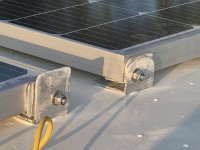
This is a closeup of the inner panel brackets. Because the roof is canted somewhat, these brackets place the panels closer to the roof. I initially wanted to pass the bolt through from the outside, but it was too much of a PITA to get a nut on the inside. So I put the bolt through the inside. Worked out much easier. The one roof bracket has a higher side, by accident. Forgot to cut it while making the brackets. I'll cut it or grind it off later.
[img]http://www.c-brats.com/albums/Solar-Installation/011PanelBracketsInstalled.jpg
This is a close up of one of the outer edge brackets. It sits a little taller to keep the solar panel level with the other one. I have a hinch pin to keep the brackets together. I can pull the pin, and then tilt the panel up to clean the roof under it, or if I need to do any wiring work.
As you can see, the brackets are held down to the roof with a 1/4" ss machine screw. I pre-drilled the holes at the exact positions, and then over drilled with a 1/2" bit. Filled in the hole with epoxy, and the re-drilled the 1/4" final hole through the epoxy. I also spread some 4000 adhesive between the bracket and the roof.
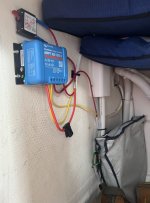
This is the solar controller and main switch. The switch is between the controller and the panels. Then there is a fuse between the controller and the battery. I located this in the closet. (Aft compartment just in front of the cabin aft bulkhead.)
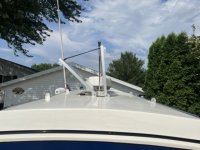
This photo shows the panels both tilted up.
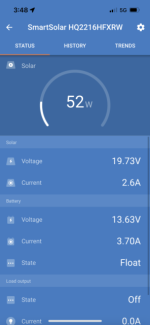
The controller works well with the Victron smart phone app. Looks like it's all working as it should.
So far I've been impressed. I've had the refrigerator going as I'm getting ready to head up to Isle Royale this week. Every day, an hour or two after sunrise, my battery is back up to 100%. It'll be interesting to see how it does with the freezer on board. Colby





